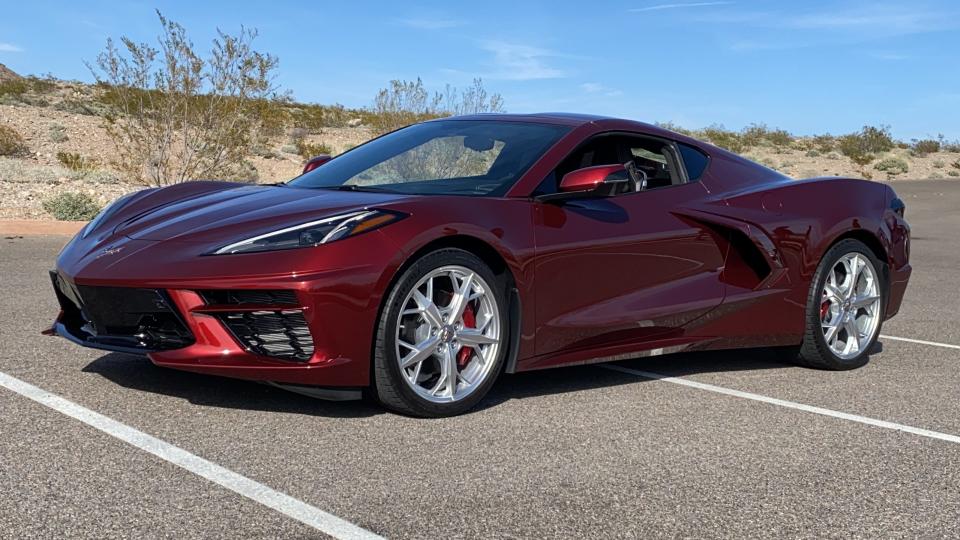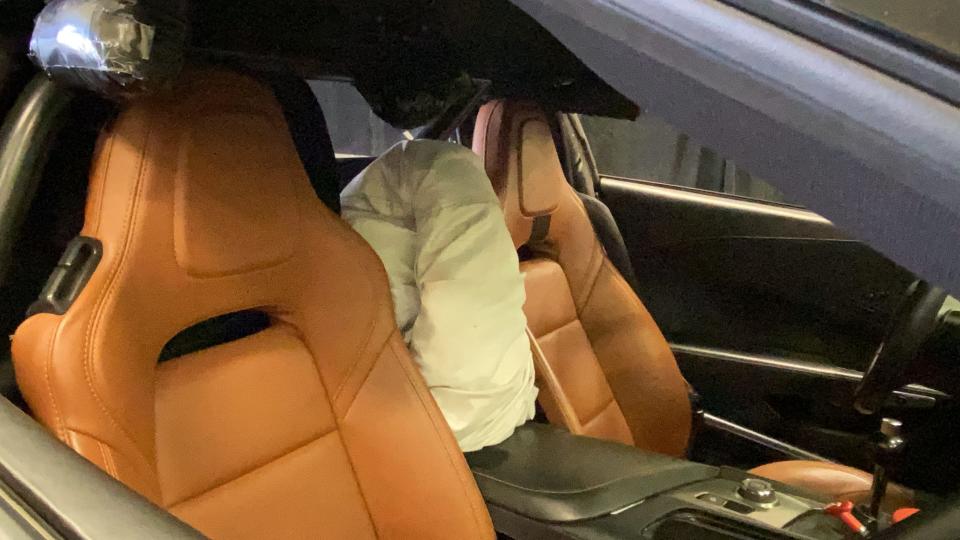Flying Car Mode and other secrets of the 2020 Corvette Stingray
LAS VEGAS – Evading helicopter surveillance and channeling the spirit of the “godfather of the Corvette” were business as usual for GM engineers developing the 2020 Chevrolet Corvette Stingray, code-named C8 because it’s the eighth generation of the sports car.
The first mid-engined production car in Corvette history, the new Stingray had near-mythic status before it ever turned a wheel and has won nearly every major new car award since it debuted in 2019. The first production models will arrive at dealers in late February or early March.
Chevrolet engineers and designers wanted to make a mid-engine ’vette since at least 1960, when engineer Zora Arkus-Duntov led the creation of Chevrolet Engineering Research Vehicle No. 1, or CERV I. Zora, a brilliant engineer and racing driver, transformed the 1950s Corvette from a car that was lovely but slow into America’s great sports car. He wanted to move the engine from the nose to behind the passenger compartment. Called mid-engined, that arrangement lets cars use more power than the traditional front-engine layout because the engine’s weight over the rear wheels keeps the tires from spinning when the driver floors it.

Consumer Reports: These are the top 10 best new cars, trucks, SUVs of 2020
$13 for a box of cereal?: General Mills offers high-priced breakfast option
‘Nothing to see here. I’m just an Australian pickup’
Plans to build a mid-engine Corvette were closely held even within GM. Around 2014, the team built a card-access-only room inside a secure corner of GM’s tech center for the first prototype. Code-named Blackjack, the two-seater hid the C8’s chassis and suspension under what appeared to be the body of the Holden Ute, a sporty, car-based pickup made by GM’s Australian brand.
“It was a convenient shape to hide a mid-engine layout,” C8 lead development engineer Mike Petrucci said.
The only actual Holden parts on Blackjack are the brand’s chrome badge, headlights, outside mirrors and taillights, but the ruse worked. The one-of-a-kind “mule,” as development vehicles are sometimes called, served for two years of development drives – frequently at night, so not even other GM engineers would see it – at GM’s proving grounds in Milford, Michigan, and Yuma, Arizona.
Building Blackjack – by hand – took eight months. The interior came from the C7 Corvette that was in production. Its body panels were handmade fiberglass, carefully shaped to look like a Ute while covering the C8’s bones. Those bones were milled from 7,000 pounds of aluminum ingots, work done secretly at other GM facilities.
‘Incoming, hide the ’vette!’
Despite GM’s secrecy, rumors leaked that a mid-engine ’vette was again under consideration. It became the top target for spy photographers who specialize in getting pictures of vehicles automakers are developing. Good photos of the fabled project could make somebody’s career, not to mention a stack of dough higher than the car.
In addition to staking out GM’s proving grounds and areas automakers develop vehicles – Death Valley in the summer, Finland in winter – photographers hired helicopters to fly over the Milford proving grounds. Buzzing Yuma was verboten, its airspace restricted because of nearby U.S. military installations.

By this time, Blackjack had been replaced by mules that were clearly for a two-seat sports car. A single clear photo would let the cat out of the bag.
The answer was a better bag: A fabric car cover designed to be folded and stowed between the development car’s seats. Development drivers were told to keep the windows open a crack, pull over, leap out and unfurl the car cover over the mule at the first sound of helicopter rotors.
They stood next to the covered car, waving at choppers on at least a dozen occasions.
A wing like no other
A close look at the tall black wing rising above Blackjack’s tailgate reveals that it’s upside down, the exact opposite of the profile you see on race cars. Though most automotive wings generate aerodynamic downforce – air pressure that pushes the vehicle down so it doesn’t leave the ground at high speed – Blackjack’s wing creates aerodynamic lift, like a plane’s wing.
Wind tunnel tests showed Blackjack’s body had aerodynamic lift at the nose. That’d be unacceptable in a production car, but since Blackjack’s body would never be built, the only thing that mattered was that its aerodynamic profile be equal front and rear. Creating downforce would be the production body’s job.

The two stanchions supporting the wing double as air intakes to cool the engine.
The C8’s performance targets – speed, aerodynamics, braking, fuel efficiency, etc. –were set during hundreds of thousands of computer tests before Blackjack was built.
What would Zora do?
GM had never built a car like the C8, so the engineering team had to invent many processes on the fly.
“At every turn, we asked ourselves, ‘What would Zora do?’ ” chief engineer Ed Piatek said.
Arkus-Duntov, the godfather of the Corvette, pushed the performance envelope at GM from the day he joined the company in 1953, first and foremost by making Corvettes faster and better.
Never afraid to ruffle feathers, while working at GM, Duntov took time off to drive for Porsche at the famous 24 Hours of Le Mans race, winning once. Legend has it he got company approval by promising to bring back competitive intelligence about Porsche, but he also helped the German automaker improve its performance with suspension modifications.

To ensure every member of the C8 team understood the legacy they had the opportunity to complete, they wore bright yellow – the color of Corvette race cars that have won many Le Mans races – and “What Would Zora Do?” wristbands, making that the standard for decision-making.
Flying car mode
The optional adaptive Magnetic Ride Control shock absorbers talk to the Corvette’s traction control system, a feature that comes in handy at high speeds on the track, vehicle performance manager Alex MacDonald said.
When a car goes airborne at very high speeds, normal traction control senses the rear wheels spinning and responds as if they were on ice or another slippery surface: It slows them.
That’s a handy feature in normal driving, but slowing the powered wheels costs you time on the racetrack. In performance traction mode, the front shocks communicate that they’ve got no weight on them – meaning they’re in the air. The rear wheels will inevitably follow, but the traction control is told to ignore it and keep sending power when they start spinning, because it knows all four wheels will be on the ground again momentarily. The result, a quicker lap time.
Memory for obstacles
Front bumpers and air splitters that hug the ground look good and improve performance, but they’re easy to damage on steep driveways and tall parking blocks. The Corvette’s suspension can raise the nose an inch to avoid such obstacles.
An optional feature called GPS-based front lift can remember up to 1,000 spots where you raised the nose. When you approach one, it raises the nose an inch at up to 25 mph.
A front camera can be used to look down from the nose to spot obstacles when parking.
2020 Corvette Stingray fun facts
74% of orders are for the coupe, 26% for the convertible, which doesn’t go into production til April.
The most popular color is Torch Red.
GT2 seats with carbon fiber trim are most popular.
There are 2,600 C7 Corvettes left at dealers, likely to fall to 2,000 by March 1.
“Corvette Academy” features 24 videos on the 2020 Stingray’s development and features.
Contact Mark Phelan: 313-222-6731 or mmphelan@freepress.com. Follow him on Twitter @mark_phelan. Read more on autos and sign up for our autos newsletter.
This article originally appeared on Detroit Free Press: 2020 Corvette Stingray: Flying Car Mode, spying choppers, more secrets

